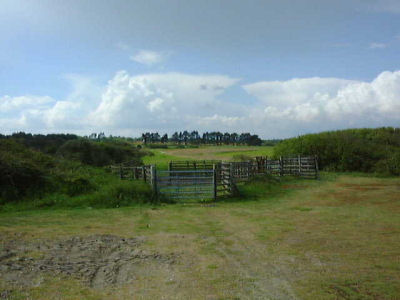
The North Warren and Haven Local Nature Reserve
A Draft Model for Linking the Outcomes of Site Operations with Appropriate Strategic Targets of the Suffolk BAP

Entrance from Aldeburgh/Thorpeness road
SITE
This local nature reserve consists of three blocks of land in multiple ownership: 'North Warren', 'Aldringham Walks' and 'The Haven'.
North Warren comprises five main habitats - lowland wet grassland, reedbed, heathland, woodland and shingle bank - within a relatively small area. The wet grassland supports up to five species of breeding waders plus nationally important populations of wintering wildfowl, including some of the UK's only regular tundra bean geese. The heathland holds Dartford warblers and woodlarks, while bitterns and marsh harriers can be seen in the reedbeds.
Aldringham Walks are ancient sheep 'walks' consisting of a mosaic of heather-dominated heathland, grassland, bracken, pine, birch andgorse scrub, and woodland. The heathland is usually dominated by heather Calluna vulgaris and sometimes bell heather Erica cinerea is found. In 1986, one-third of the remaining heathland site area was covered in bracken, and nearly one-third was covered with woodland or scrub. Recent management has been in favour of altering the proportions of these vegetation types to increase the area of heathland.
The Haven is situated between the town of Aldeburgh and village of Thorpeness. This was once, for the most part, a marine inlet and saltwater marsh. It now consists mostly of wet grassland grazed by cattle during the summer. The grassland is an important refuge for migrating wildfowl during the winter. It has important communities of wild flowers growing on both the shingle bar and the marsh edge. Yellow-horned Poppy, Sea Kale and Sea Pea all thrive here. Ground nesting birds such as Ringed Plovers are also found on the shingle beach and migrant Clouded Yellow butterflies may be seen in the summer months. Patches of goarse and scrub provide important cover for nesting Linnets and Whitethroats.
The land is managed through a three-way partnership also involving the, the RSPB, Suffolk Wildlife Trust and Suffolk Coastal District Council.
Click here to see maps of the above compartments
Click her to see pictures of the reserve
OPERATIONS
BACKGROUND
Commercial Use
Recreational Use
Research,Survey and Monitoring
Main Conservation Management Already Achieved
Position in an Ecological Unit
Identification/Confirmation of Important Features
Operations Likely to Damage Special Features
FIVE YEAR WORK PROGRAMME
APPENDICES